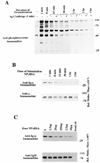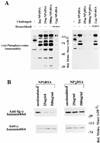Antigen-stimulated dissociation of BCR mIg from Ig-alpha/Ig-beta: implications for receptor desensitization
- PMID: 10072076
- PMCID: PMC3931429
- DOI: 10.1016/s1074-7613(00)80024-2
Antigen-stimulated dissociation of BCR mIg from Ig-alpha/Ig-beta: implications for receptor desensitization
Abstract
B cell antigen receptor (BCR) ligation leads to receptor desensitization wherein BCR remain competent to bind antigen and yet fail to transduce signals. Desensitized BCR exhibit a defect at the most proximal level of signal transduction, consistent with failed transmission of signals through the receptor complex. We report that antigen stimulation leads to dissociation or destabilization of the BCR reflected by inability to coimmunoprecipitate Ig-alpha/Ig-beta with mIg. This destabilization is temporally correlated with desensitization and occurs in BCR containing mIgM and mIgD. Induction of BCR destabilization requires tyrosine kinase activation but is not induced by phosphatase inhibitors. BCR destabilization occurs at the cell surface and "dissociated" Ig-alpha/Ig-beta complexes remain responsive to anti-Ig-beta stimulation, suggesting that mIg-transducer uncoupling may mediate receptor desensitization.
Figures







Similar articles
-
Transmodulation of BCR signaling by transduction-incompetent antigen receptors: implications for impaired signaling in anergic B cells.J Immunol. 2002 May 1;168(9):4344-51. doi: 10.4049/jimmunol.168.9.4344. J Immunol. 2002. PMID: 11970976 Free PMC article.
-
Cross-linking of the IgM receptor induces rapid translocation of IgM-associated Ig alpha, Lyn, and Syk tyrosine kinases to the membrane skeleton.J Immunol. 1997 Aug 1;159(3):1096-106. J Immunol. 1997. PMID: 9233602
-
Rapid desensitization of B-cell receptor by a dithiol-reactive protein tyrosine phosphatase inhibitor: uncoupling of membrane IgM from syk inhibits signals leading to Ca2+ mobilization.Immunol Lett. 1995 Jan;44(2-3):149-56. doi: 10.1016/0165-2478(94)00207-8. Immunol Lett. 1995. PMID: 7541023
-
Tyrosine kinase activation in the decision between growth, differentiation, and death responses initiated from the B cell antigen receptor.Adv Immunol. 2000;75:283-316. doi: 10.1016/s0065-2776(00)75007-3. Adv Immunol. 2000. PMID: 10879287 Review.
-
Signal transduction by the B-cell antigen receptor.Ann N Y Acad Sci. 1995 Sep 7;766:195-201. doi: 10.1111/j.1749-6632.1995.tb26662.x. Ann N Y Acad Sci. 1995. PMID: 7486656 Review.
Cited by
-
Essential role of membrane cholesterol in accelerated BCR internalization and uncoupling from NF-kappa B in B cell clonal anergy.J Exp Med. 2006 Jul 10;203(7):1773-83. doi: 10.1084/jem.20060552. Epub 2006 Jun 26. J Exp Med. 2006. PMID: 16801401 Free PMC article.
-
Understanding B cell activation: from single molecule tracking, through Tolls, to stalking memory in malaria.Immunol Res. 2009;43(1-3):85-97. doi: 10.1007/s12026-008-8052-y. Immunol Res. 2009. PMID: 18810335 Free PMC article.
-
Early preplasma cells define a tolerance checkpoint for autoreactive B cells.J Immunol. 2006 Jan 15;176(2):790-802. doi: 10.4049/jimmunol.176.2.790. J Immunol. 2006. PMID: 16393962 Free PMC article.
-
The transmembrane tyrosine of micro-heavy chain is required for BCR destabilization and entry of antigen into clathrin-coated vesicles.Int Immunol. 2007 Dec;19(12):1403-12. doi: 10.1093/intimm/dxm110. Epub 2007 Nov 1. Int Immunol. 2007. PMID: 17981794 Free PMC article.
-
Preclinical Analysis of Candidate Anti-Human CD79 Therapeutic Antibodies Using a Humanized CD79 Mouse Model.J Immunol. 2022 Apr 1;208(7):1566-1584. doi: 10.4049/jimmunol.2101056. Epub 2022 Mar 23. J Immunol. 2022. PMID: 35321883 Free PMC article.
References
-
- Albrecht DL, Noelle RJ. Membrane Ig-cytoskeletal interactions. I. Flow cytofluorometric and biochemical analysis of membrane IgM-cytoskeletal interactions. J. Immunol. 1988;141:3915–3922. - PubMed
-
- Braun J, Hochman PS, Unanue ER. Ligand-induced association of surface immunoglobulin with the detergent-insoluble cytoskeletal matrix of the B lymphocyte. J. Immunol. 1982;128:1198–1204. - PubMed
-
- Brunswick M, June CH, Mond JJ. B lymphocyte immunoglobulin receptor desensitization is downstream of tyrosine kinase activation. Cell. Immunol. 1994;156:240–244. - PubMed
-
- Cambier JC. New nomenclature for the Reth motif (or ARH1/TAM/ARAM/YXXL) Immunol. Today. 1995;16:110. - PubMed
Publication types
MeSH terms
Substances
Grants and funding
LinkOut - more resources
Full Text Sources
Other Literature Sources
Research Materials
Miscellaneous

